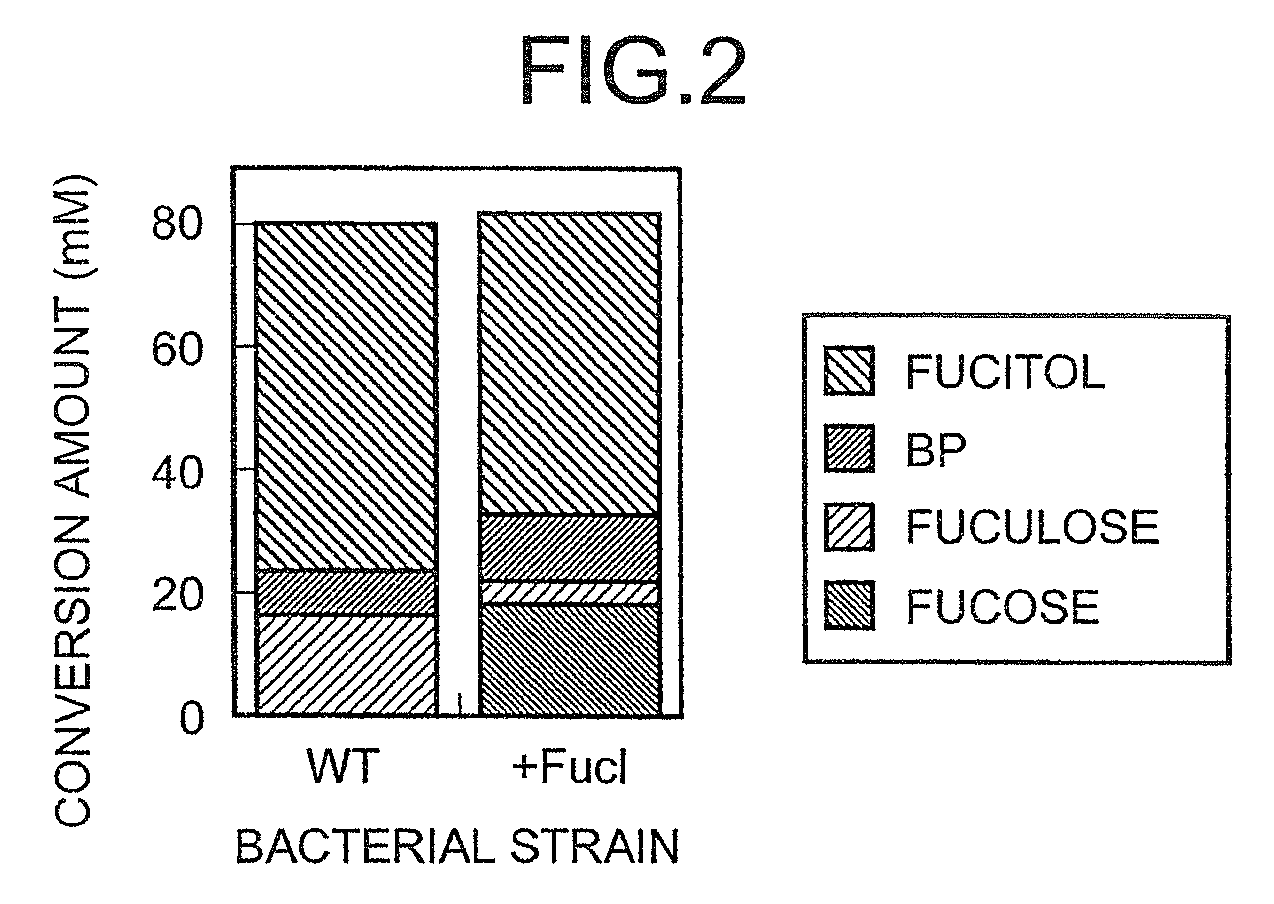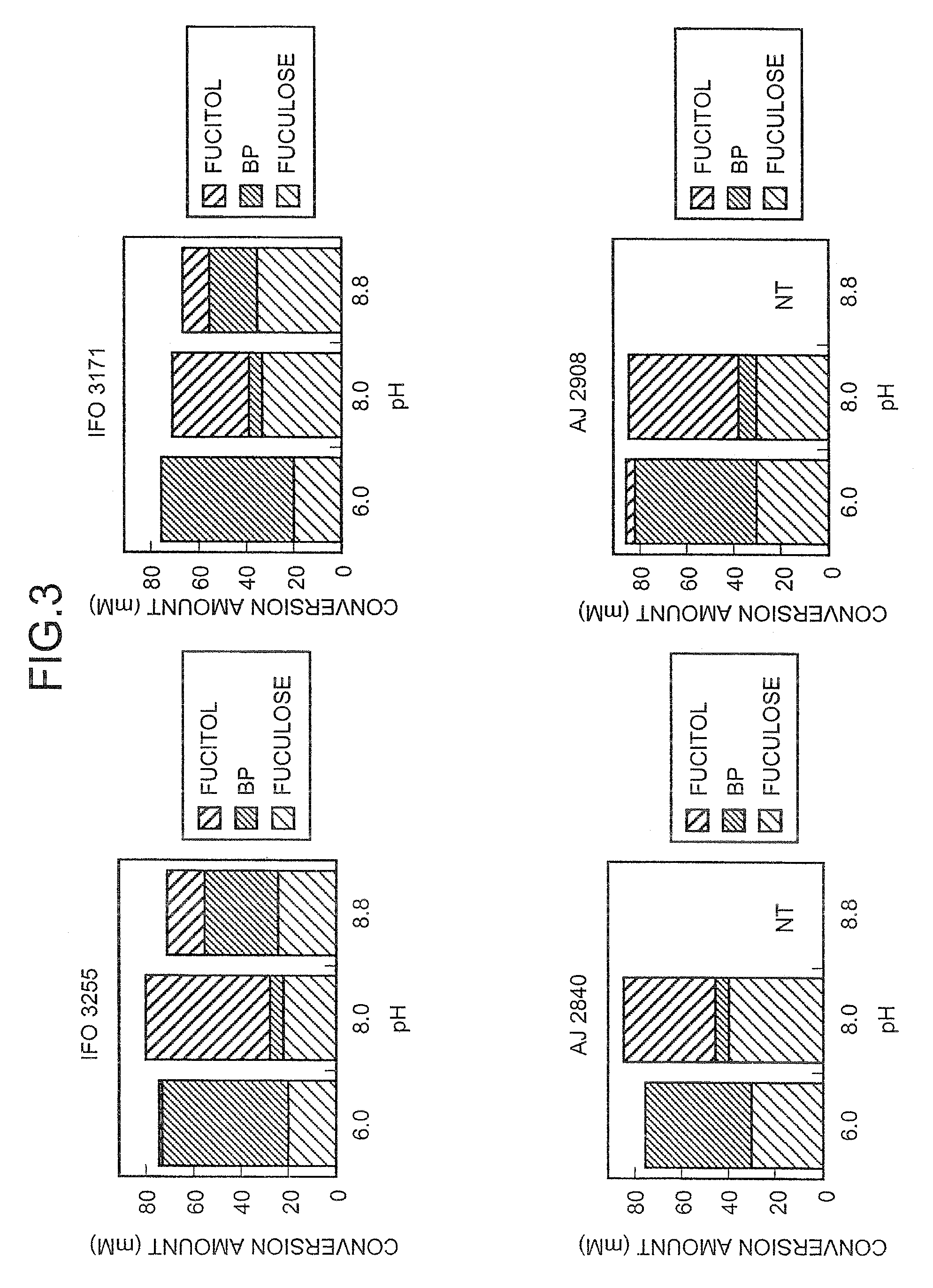Method for producing L-fuculose and method for producing L-fucose
a technology of l-fuculose and l-fucose, which is applied in the field of methods for producing l-fuculose and l-fucose, can solve the problems of large amount of i>nemacystus decipiens/i>, small yield, and difficult to isolate and purify the product, so as to achieve efficient and less expensive
- Summary
- Abstract
- Description
- Claims
- Application Information
AI Technical Summary
Benefits of technology
Problems solved by technology
Method used
Image
Examples
example 1
A Microorganism which Oxidizes L-Fucitol to Synthesize L-Fuculose
[0176]Each of the acetobacterium strains was cultured on YPG agar medium (10 g / l glycerol, 0.3 g / l yeast extract, 0.3 g / l peptone, 20 g / l agar, pH 6.5) at 30° C. for 18 to 66 hours, and one platinum loopful of each culture was then seeded into 0.5 mL of a liquid medium containing 10 g / l (61 mM) L-fucitol, 10 g / l glycerol, 3 g / l yeast extract, 3 g / l peptone, and 20 g / l CaCO3 pH 6.5 that had been sterilized by autoclaving at 120° C. for 20 minutes. Cultivation was then performed with shaking at 30° C. for 42 hours. A 96-well microplate having 2 ml volume per well was used for the cultivation. Microbial cells were then removed from the medium by centrifugation. The supernatant was analyzed by high performance liquid chromatography (HPLC) to determine the concentration of L-fuculose. Analysis conditions for HPLC were as follows:[0177]column: Sugar SC1011 supplied from Shodex, diameter: 10 mm, length: 300 mm[0178]column tem...
example 2
A Microorganism which Oxidizes L-Fucitol to Synthesize L-Fuculose
[0185]In order to induce the expression of an enzyme which oxidizes L-fucitol using dulcitol, the structure of which is similar to that of L-fucitol, each of the acetobacterium strains was cultured on YP-dulcitol agar medium (10 g / l dulcitol, 0.3 g / l yeast extract, 0.3 g / l peptone, 20 g / l agar, pH 6.5) at 30° C. for 18 to 66 hours, and one loopful of each strain was then seeded into 0.5 mL of the liquid medium containing 10 g / l L-fucitol, 3 g / l yeast extract and 3 g / l peptone pH 6.5 that had been sterilized by autoclaving at 120° C. for 20 minutes. Cultivation was then performed with shaking at 30° C. for 42 hours. This cultured medium was analyzed in the same way as in Example 1. The analysis results are shown in Table 2.
[0186]
TABLE 2MICROORGANISMS WHICH PRODUCEL-FUCULOSE FROM L-FUCITOL (2)L-L-FUCULOSE / FUCULOSEBPL-FUCITOL(L-FUCULOSE + BP)Strain(mM)(mM)(mM)(wt %)G. xylinus subsp. xylinus ATCC535827.80.048.5100.0Glucono...
example 3
Identification of Substance Assumed to be L-Fuculose by HPLC Analysis
[0188]In order to identify the substance which was assumed to be L-fuculose by HPLC analysis, a bioassay using L-fucose isomerase was conducted.
[0189]L-Fucose isomerase (EC 5.3.1.3., referred to hereinbelow as “FucI”) catalyzes isomerization between L-fuculose and L-fucose. If the compound assumed to be L-fuculose in Examples 1 and 2 is L-fuculose, this compound should convert to L-fucose in the presence of FucI. Commercially available L-fucose (e.g., Sigma) is available. Utilizing this product as a standard, it is possible to perform HPLC analysis or a colorimetric quantification using L-fucose dehydrogenase described in Patent No. 3132913 Publication.
[0190]FucI was isolated from E. coli K12 strain. This enzyme has been registered with accession number AAC75844 in the database of National Center for Biotechnology Information. To express this enzyme in large amounts in E. coli, and also to insert a histidine tag at...
PUM
| Property | Measurement | Unit |
|---|---|---|
| temperature | aaaaa | aaaaa |
| pH | aaaaa | aaaaa |
| temperature | aaaaa | aaaaa |
Abstract
Description
Claims
Application Information
 Login to View More
Login to View More - R&D
- Intellectual Property
- Life Sciences
- Materials
- Tech Scout
- Unparalleled Data Quality
- Higher Quality Content
- 60% Fewer Hallucinations
Browse by: Latest US Patents, China's latest patents, Technical Efficacy Thesaurus, Application Domain, Technology Topic, Popular Technical Reports.
© 2025 PatSnap. All rights reserved.Legal|Privacy policy|Modern Slavery Act Transparency Statement|Sitemap|About US| Contact US: help@patsnap.com



